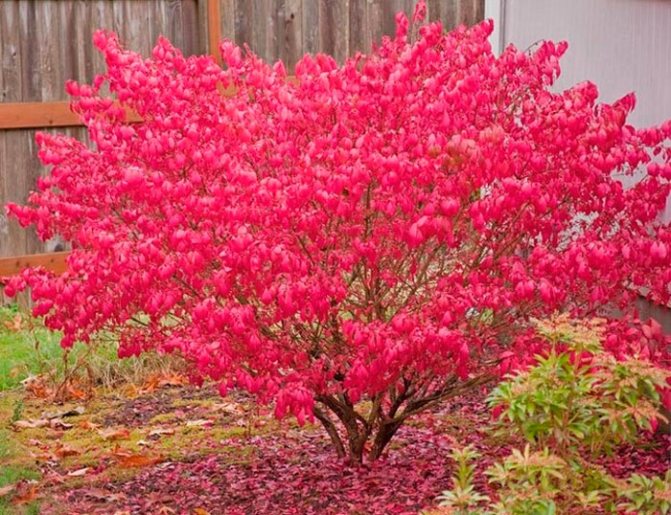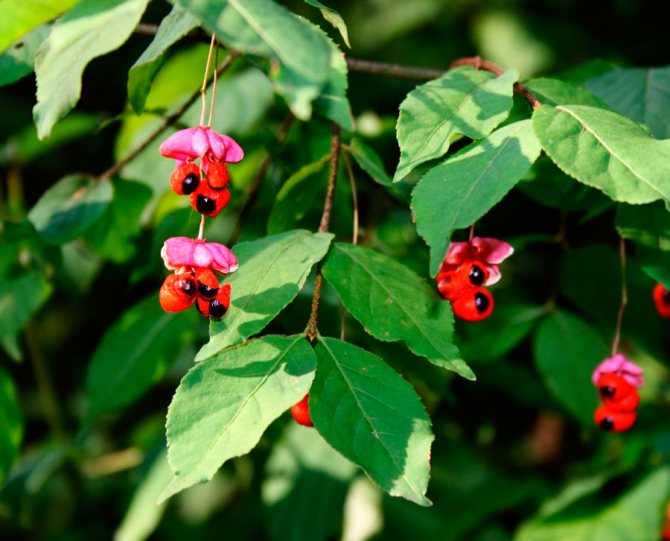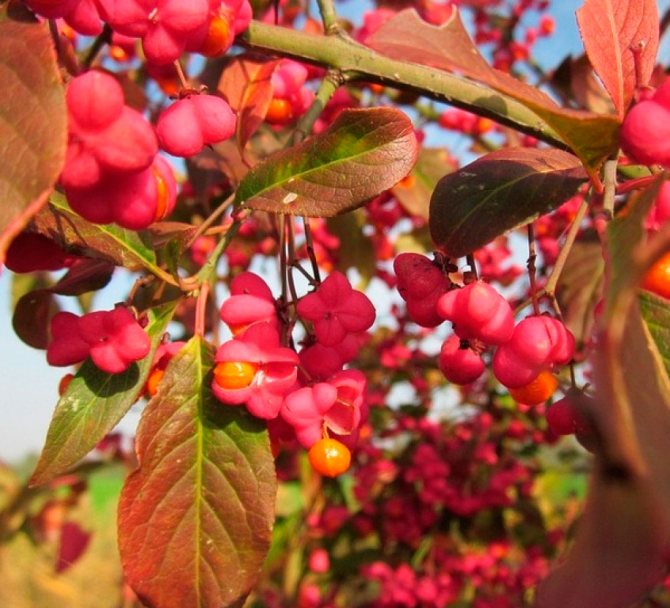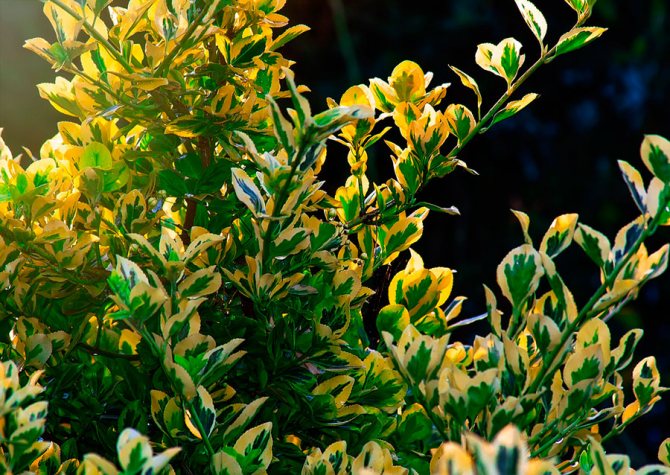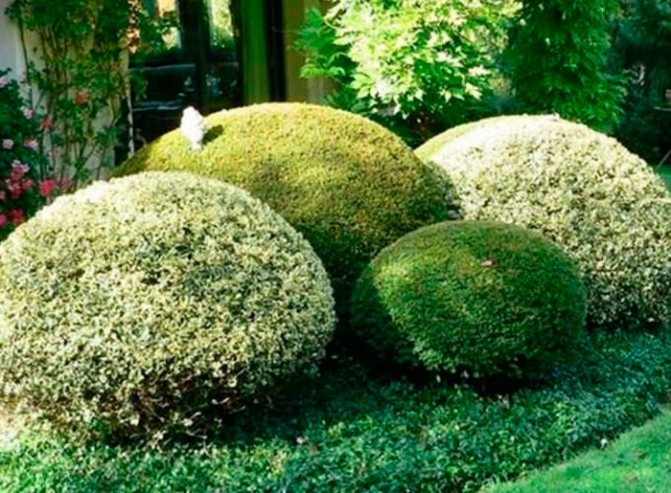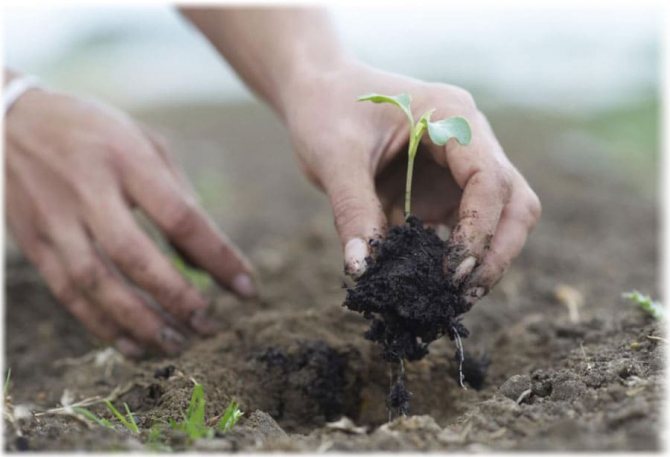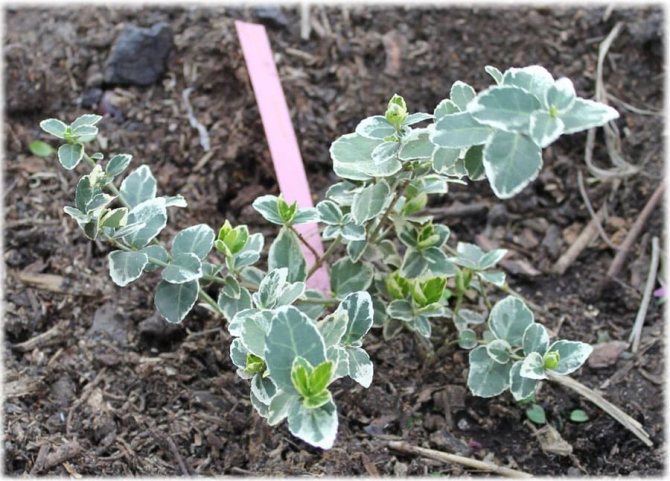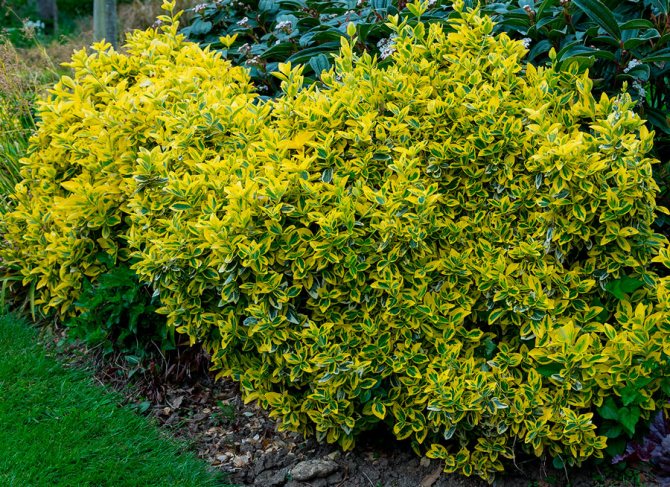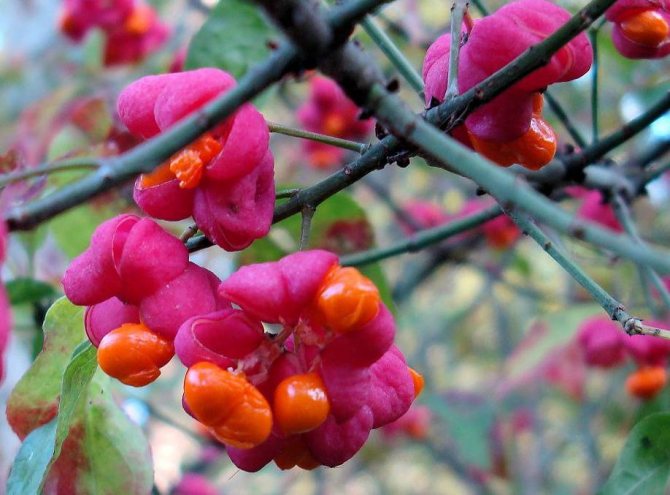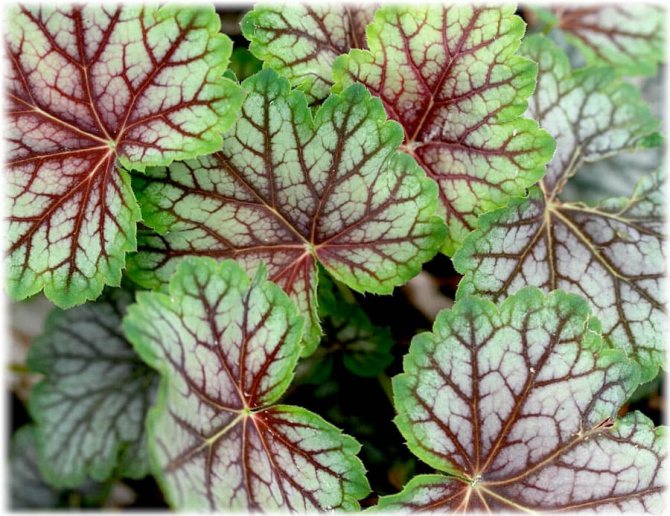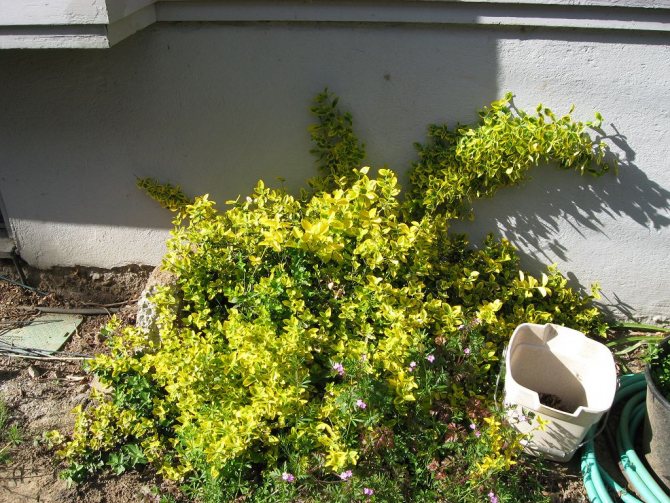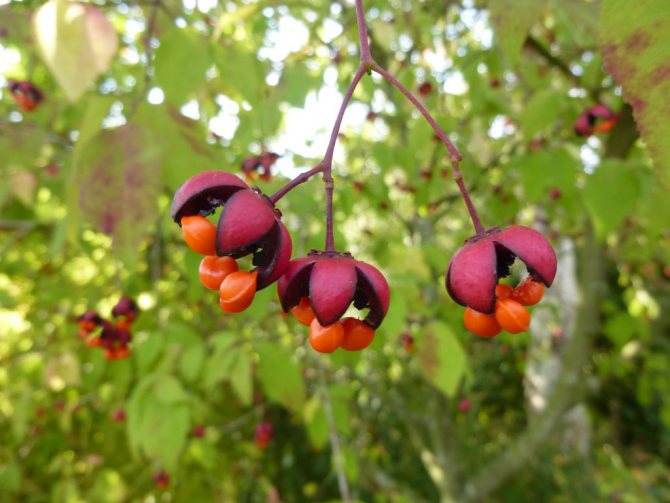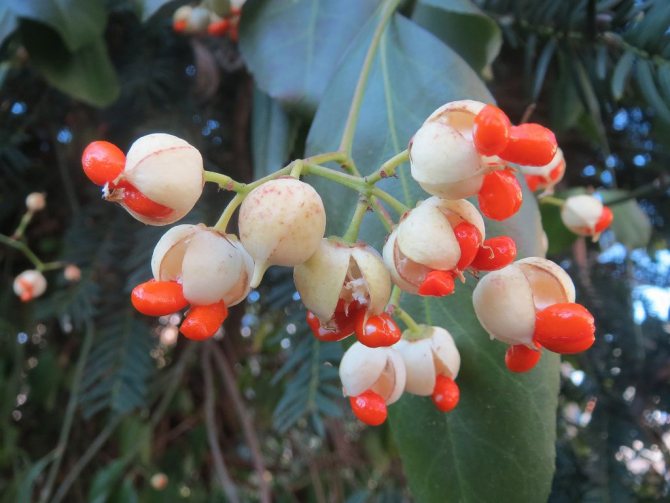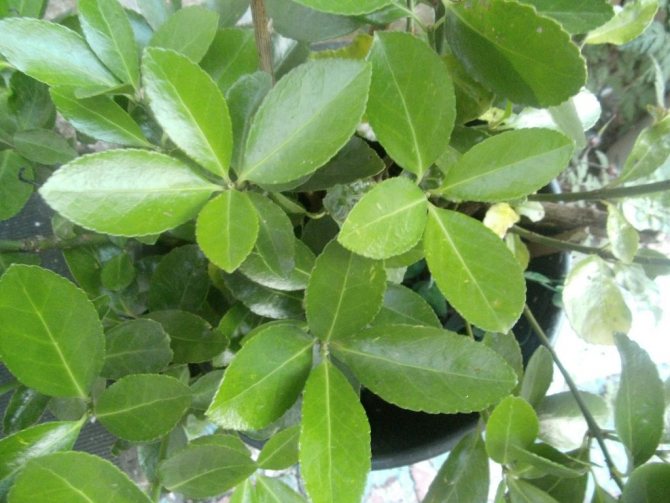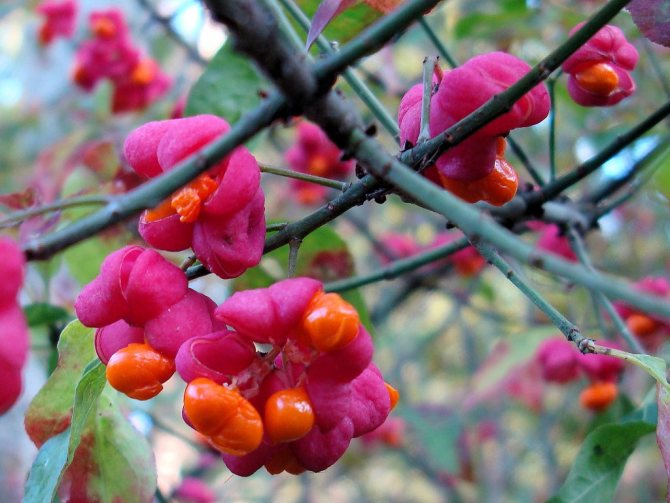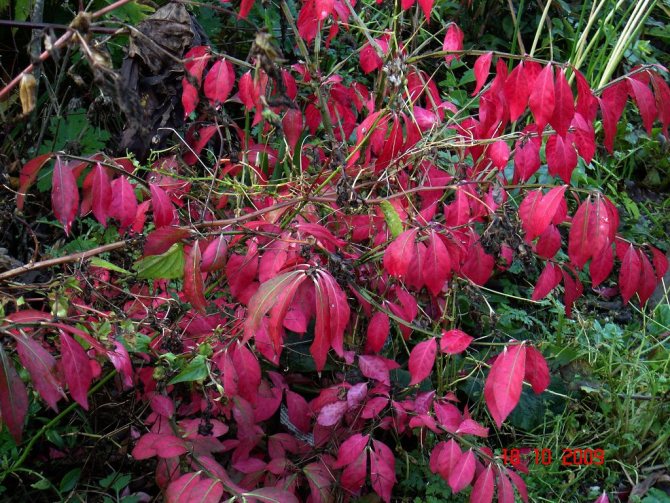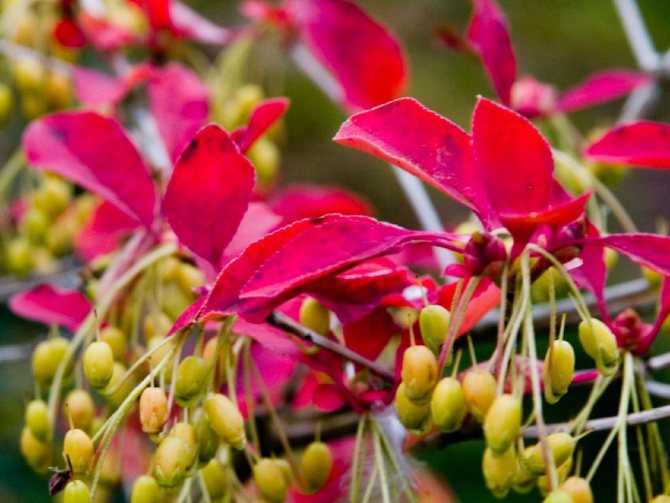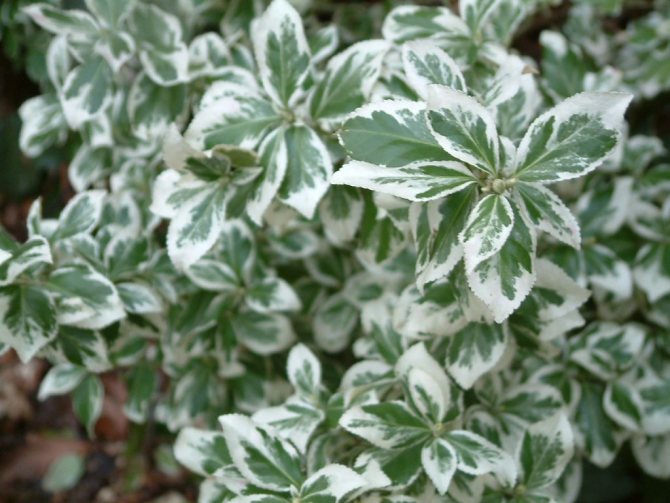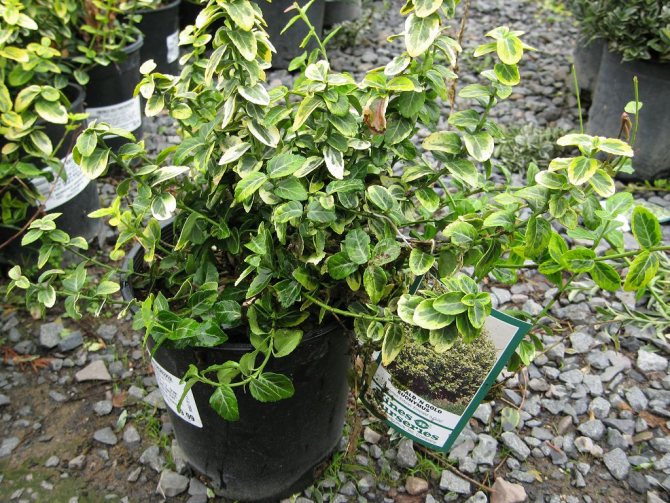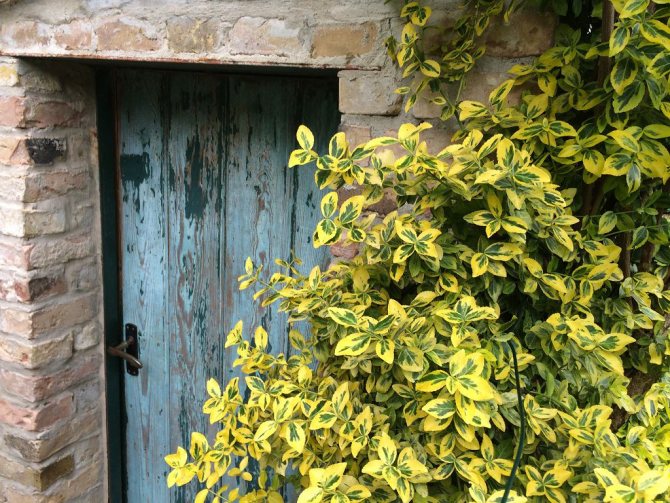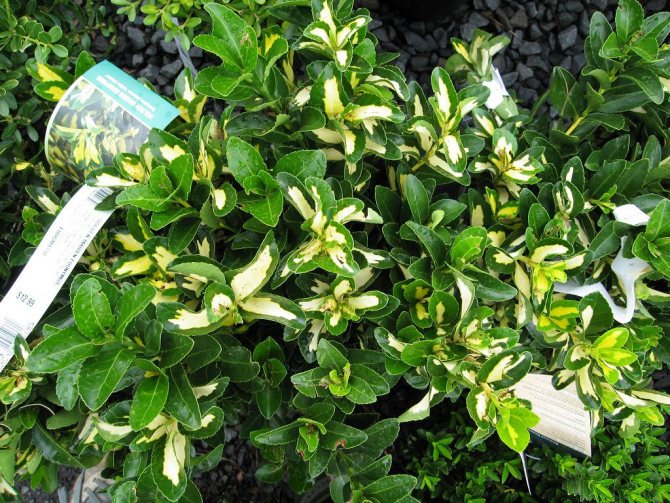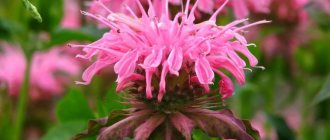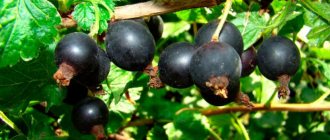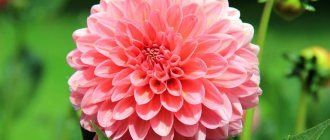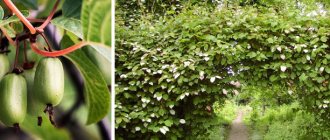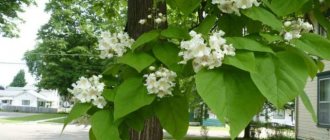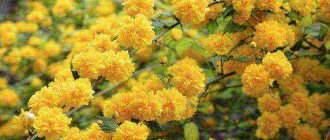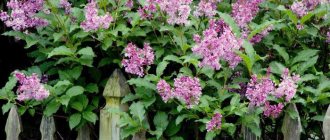Euonymus is an ornamental, deciduous or evergreen shrub belonging to the euonymus family. About two hundred species have already been studied and described. The homeland of this plant is America, Asia, Australia and Europe. Grows in river valleys and mixed forests.
In the wild, some species of euonymus grow up to ten meters. At home, flower growers prefer the cultivation of creeping varieties, as well as shrubs that do not exceed 1.5 meters. The plant lives and pleases with its beauty for about 60 years.
[Hide]
Varieties and types
Winged euonymus - This species is an ornamental deciduous shrub. It has a dense and spreading crown that reaches four meters in height. The branches of the plant are tetrahedral. At the end of spring, elongated dark green leaves are released. In September, the foliage takes on a color from bright red to crimson.
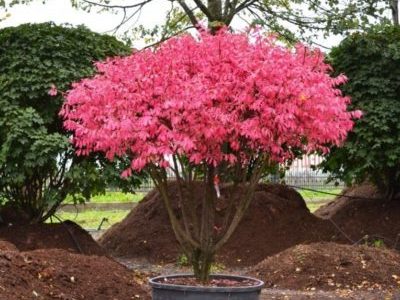
Winged euonymus compactus Is a deciduous variety of winged euonymus. The prefix "compactus" means that the shrub has a crown that grows into a spherical shape. It doesn't need to be trimmed to get a decorative look. Otherwise, this species does not differ from the winged spindle tree.
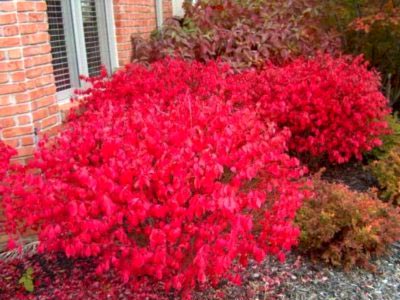

European spindle tree - unpretentious deciduous shrub that tolerates air pollution and low temperatures well. It has long green leaves, which turn maroon in early autumn. It is notable for the fact that every year a large number of bright red seed bolls are tied on it.
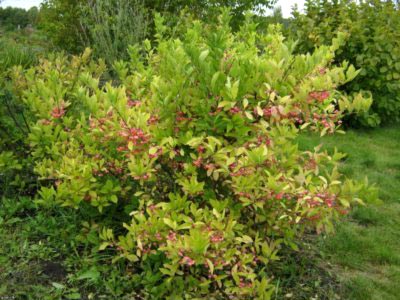

Warty euonymus Is a deciduous shrub that grows up to two meters in height. It has a spreading crown and dense foliage, which turns pink in autumn. A distinctive feature of the shrub is the shoots covered with brown warts.
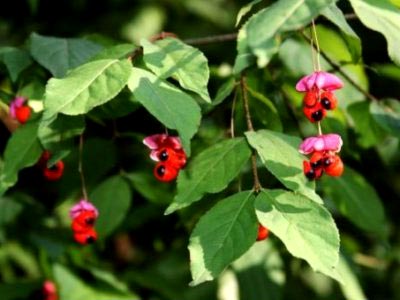

Fortune's eonymus
An evergreen plant that spreads widely on the ground. It can grow up to three meters wide. The total height of the shrub does not exceed 60 cm. The crown is dense, covered with a large number of leaves with an original color - green with a golden or silvery sheen.
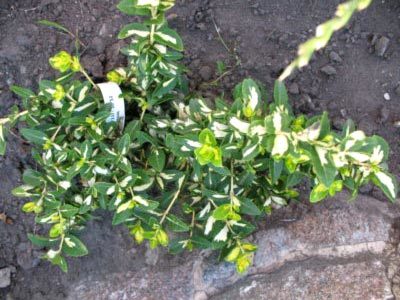

Fortune's euonymus includes popular varieties:
- «Emerald Gold»- shrub with dense foliage of green-yellow color. In winter, the yellow tones change to pink tones.
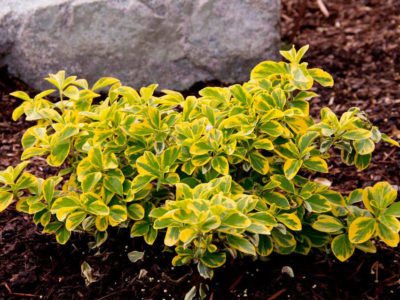

- «Emerald Gaety"- a shrub with a dense spherical crown and dark green foliage with a cream frame. With the onset of cold weather, the leaves turn pink.
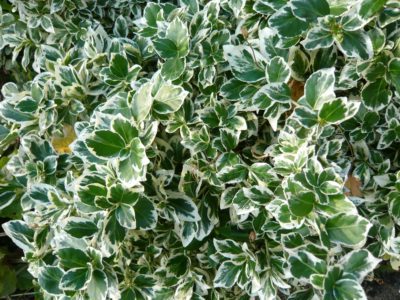

Japanese euonymus - an evergreen plant with long green leaves with a cream or golden frame. The entire bush grows vertically. Branches branch out from the main trunk in different directions. In the middle of summer, flowers appear in a yellow-green hue. They bloom in large groups of fifteen. Japanese varieties are growing rapidly. For a year, they can add up to twenty centimeters in height.
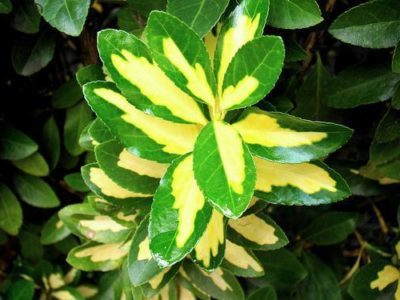

Dwarf euonymus - an evergreen plant, reaching no more than a meter in height. Thanks to the creeping stems, the shrub easily takes root in the soil, and grows well in width. It has narrow petals of a dark green shade with small jagged edges. Blooms in early June with small green-red flowers.
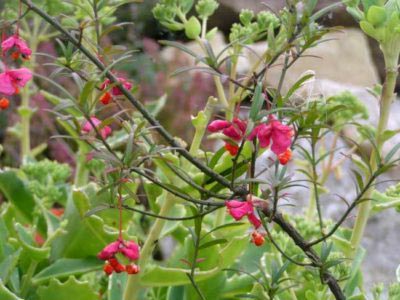

Maak's euonymus - deciduous shrub or multi-stemmed tree growing up to 4-11 meters in height.Shoots are flat green with a dark gray bloom. Petals are oval, up to 10 cm long and up to 5 cm wide. Begins to bloom in late June with small white flowers. In September, seed bolls of a dark red hue appear.
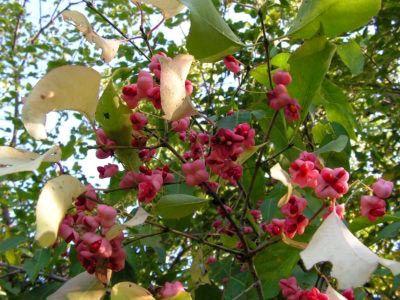

Beresklet Maksimovich - a deciduous shrub or tree that grows up to seven meters in height. It has oval-shaped green leaves, which turn pink in early autumn. It blooms in June with inconspicuous white-green flowers. Begins to bear fruit in October.
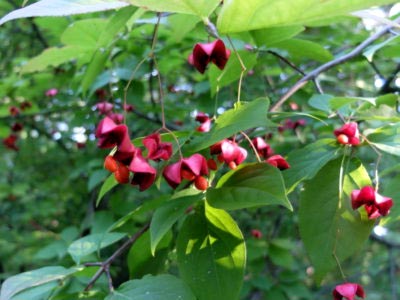

Sacred eonymus
Deciduous shrub with a spreading crown that grows up to 1.5 meters. It has tetrahedral shoots with lateral plates resembling wings. The foliage is dark green with small serrations at the edges, reaching 8 cm in length. The shrub blooms in late May with small green-red or white-green flowers. In autumn, the leaves turn bright burgundy.
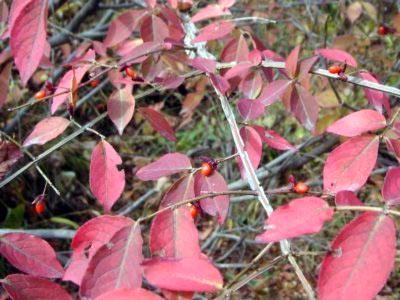

Big-winged spindle tree - a deciduous shrub or branchy tree that grows up to ten meters. Branches are covered with dark bark with green shoots. The leaves reach 12 cm in length, have an elongated shape with ribbed edges. Begins to bloom in May with white-green inconspicuous flowers. In September, fruits of a bright purple color appear, giving the shrub an unusual decorative effect.
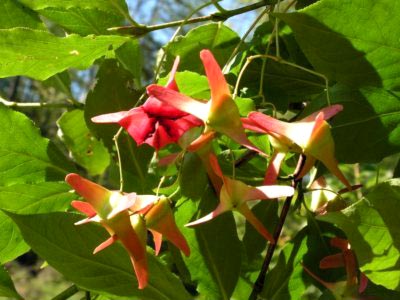

Sakhalin euonymus - a deciduous shrub with a dense crown that grows up to two meters in height. It has tough, glossy leaves of a dark green color, reaching eight centimeters in length. The shrub blooms in July with small purple flowers, which are combined into inflorescences of fifteen pieces. Produces dark pink fruits in early October.
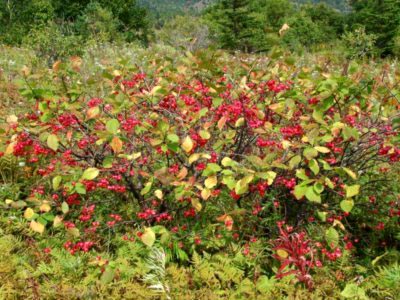

Creeping euonymus - an evergreen shrub reaching 40 cm in height. It has long shoots that take root in the soil. The foliage is tough, green with a creamy edging. The plant prefers places with moderate light.
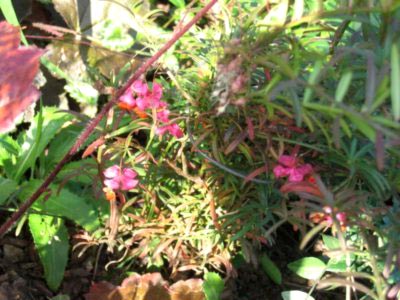

There are also many other varieties:
- Cork euonymus variety;
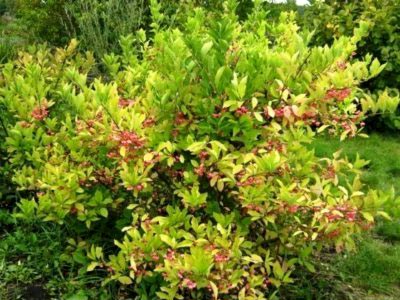

- Hamilton's euonymus;
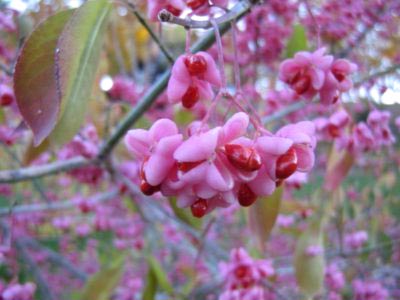

- Bunge euonymus variety;
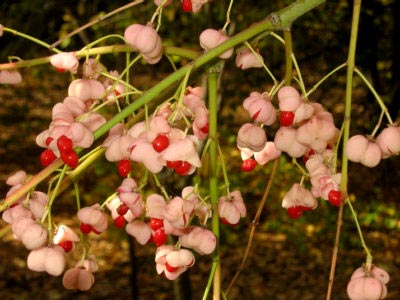

- Broad-leaved euonymus;
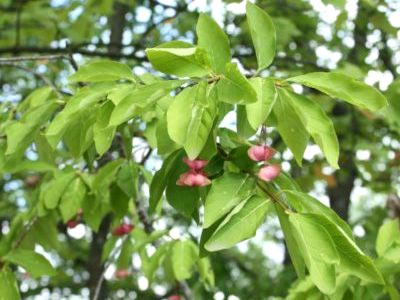

- Siebold's euonymus variety;
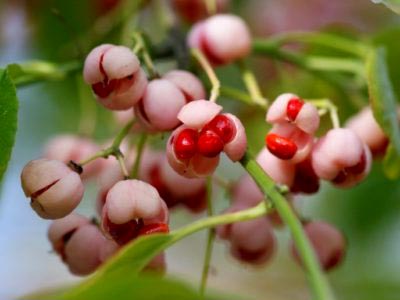

- Coopman's euonymus;
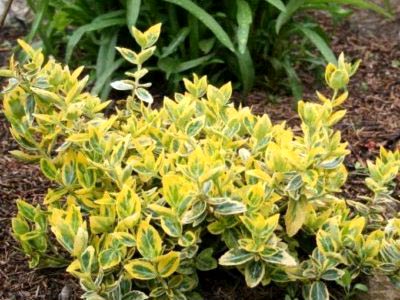

- Low-flowered euonymus variety;
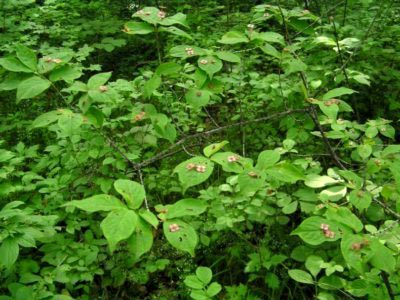

Description of the fruits of the warty spindle tree
Euonymus fruits are its main decorative highlight. At the beginning of formation, the fruits have a flattened pear-shaped shape, the color is green. There are 4 blades in the box.
Fruits ripen in August, they acquire a bright pink hue. When the capsule is opened, seeds of a black, glossy color are visible in it, the seed is orange-red. Fruits hang down on stalks that look like thin and long threads.
Additional Information! Because of the hanging long peduncles, euonymus are popularly called wolf earrings.
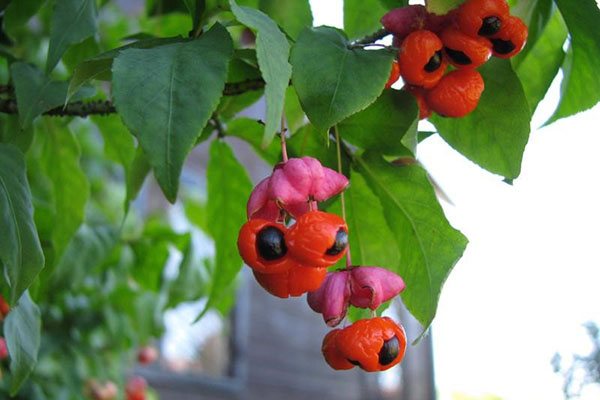

The fruits of the euonymus are bright, unusual and very healthy.
Spindle tree planting and care in the open field
The plant is planted in open ground in early spring or autumn. To do this, you need to find a suitable place with light partial shade, moderately moist and fertile soil. Creepers grow well in breadth, so choose a spacious area so that all the bushes have enough space. Other varieties grow poorly in the vicinity of large trees.
The soil for planting needs nutritious and loose. It should include: turf, sand, peat and some leafy soil. Neutral or slightly alkaline soil is suitable for growing euonymus. If the soil in your area is acidic, mix slaked lime into it.
Having picked up a place, dig a landing hole, which should be one and a half times larger than the root system of the euonymus. Make a drainage layer in the fossa. To do this, pour crushed stones into it, and sand on top.
Mix the soil removed from the hole with the fertilizer.Sprinkle the drainage with the mixture in a small layer. Spread the roots of the bush well, place in a hole and cover it with a mixture of soil.
Try to tamp the edges to prevent air pockets from forming. The neck of the roots should be flush with the ground. Plant shrubs a meter apart.
Barberry also has a very beautiful and decorative foliage color. It is grown when planting and nursing in the open field without much hassle, if you adhere to the rules of the plant's agricultural technology. You can find all the necessary recommendations for growing and caring for this plant in this article.
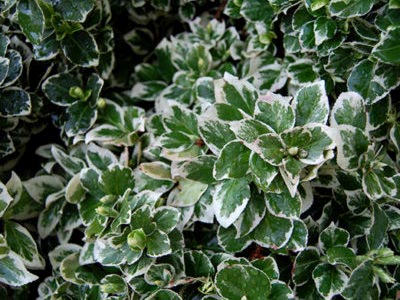

Well preparation


Shrub japanese
The pit prepared for planting should be at least 2 times larger than the root system of the seedling. A drainage layer of gravel, crushed stone or small pebbles is poured into the base of the resulting pit. Do not forget that the roots will grow, and if you are planting a small sprout and do not plan to move it to another place in the future, it is better to dig a deep large hole and drain its bottom.
The soil used is carefully loosened, peat, sand, compost are added in equal proportions and mixed, if desired, mineral and organic fertilizers are added.
The seedling is placed flush with the base of the earth. To do this, before watering, the neck of the plant should be several centimeters higher, after moistening the soil will sag and the seedling will take the desired position.
At first, after planting, the soil around the seedling is regularly moistened. However, everything is fine in moderation, and excessive watering should not be allowed, which is also detrimental to euonymus, as well as drying and cracking of the soil.
Watering euonymus
After planting, water the shrub well with water. This should be done every day for the first week. Then water as the soil around the bush dries up. Try to avoid stagnation of water in the ground. Excessive moisture will harm the euonymus.
During dry periods, mulching will help to retain moisture in the soil. For this, you can use shredded wood or pine bark. Pour a layer of mulch twenty centimeters around the bush and water.
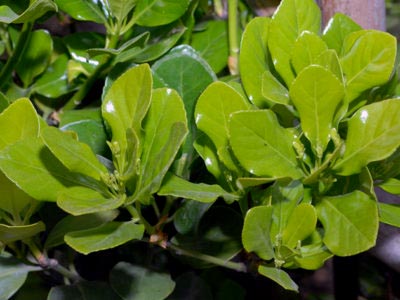

Wintering
Caring for a winged euonymus in winter is also not difficult. Adult plants do not require warming at negative temperatures, it is enough to mulch the root zone so that the roots close to the surface do not freeze out in a snowless winter.
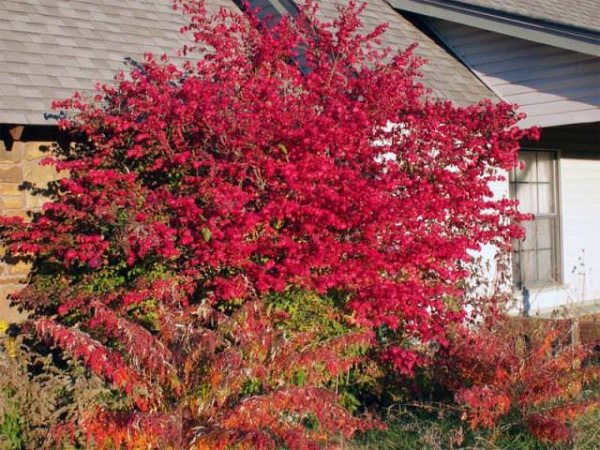

shrub in autumn
But young seedlings in the first 3 years should be preserved, for this, in addition to placing a layer of mulch around the trunk, they are covered with spruce branches, straw or stalks of Jerusalem artichoke, sunflower or corn. To prevent the structure from scattering under gusts of strong wind, a fixing stake is driven in next to the trunk and a covering material is tied to it, having previously tied it in the upper part.
Important! Do not forget that the winged euonymus does not like acidified soils, and if you decide to use spruce branches as a covering material, with the onset of spring you will need to remove all the needles.
Fertilizers for euonymus
Euonymus needs feeding, as well as other garden plants. Fertilizers help to strengthen the health of the shrub, accelerate its growth and achieve a beautiful flowering. You need to bring in food twice a season - in spring and autumn.
Feeding in April or May ensures the formation of buds and active growth of the bush. To do this, use organic fertilizers - manure or chicken droppings diluted in water.
Feeding in September provides the shrub with long flowering. During this period, the plant needs complex mineral fertilizers containing potassium and phosphorus.
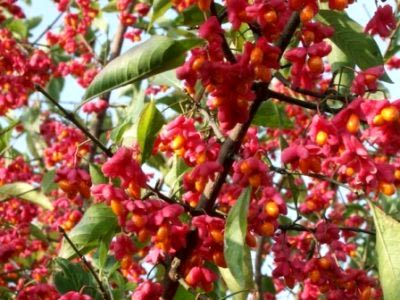

Shrub pests and diseases
Occasionally, when large colonies of aphids and spider mites appear on the personal plot, damage to the spindle tree can be observed. To combat them, folk remedies are used:
- onion peel (100 g) is infused in water (3 l) for two days;
- dry mustard (20 g) is infused in water (1 l) for two days;
- calendula flowers (0.5 kg) are filled with water (5 l) and infused for three days.
View of healthy euonymus leaves
Before using folk remedies, for better adhesion to the plant, a laundry soap is added to the composition at the rate of 40 g per 10 liters. Processing is carried out once a week. In case of severe damage, the chemical preparation "Actellik" is used.
When mealybugs appear, a two-stage treatment with the preparations Confidorm, Aktara, Fitoverm will be required with a break of 10 days.
The most common disease of this plant is trunk rot. This is a fungal infection that almost always leads to the death of the plant. A preventive measure against the appearance of rot is the treatment with a solution of Bordeaux mixture at the end of the spring season and the removal of the affected areas of the bush.
Another fungal disease dangerous for euonymus is powdery mildew. The appearance of spores of powdery meat fungi is facilitated by increased dampness, a large amount of nitrogen in the soil and thickening of the plantings.
When a characteristic white bloom appears on the leaves of the euonymus, the plant must be treated with an antifungal agent. Popular drugs:
- "Speed",
- "Topaz",
- "Vikaros",
- Fundazol.
Depending on the selected agent and the degree of damage, the treatment is carried out 2-4 times with an interval of 10 days.
Subject to all the rules of cultivation and preventive measures, diseases and pests do not bring any particular concern to the gardener. To minimize the risk of injury, it is important to observe the watering regime, avoiding the formation of excessive dampness and keeping the number of pests under control in the entire garden plot.
Euonymus pruning
Pruning helps keep the shrub healthy and decorative. Do the first pruning in the spring before foliage appears. Such a haircut is considered preventive and helps to induce active branching. To do this, remove dead branches and thin out dense areas.
Do the second pruning in the fall after fruiting. Autumn haircut is the most interesting. During this period, you can give free rein to your imagination and conduct experiments. Creative pruning will result in a unique bush shape.
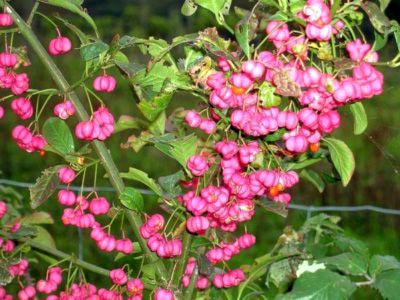

Spindle tree transplant
The main reason for changing habitat is the active growth of euonymus or obsolescence of the soil in the pot. The best time to transplant is spring.
When transplanting a plant, you need to pick up a box or pot for it, which is five centimeters larger than the previous one. If you want to stop the growth of the spindle tree, choose a container of the same diameter, but smaller in depth.
Young shrubs need a pot change every year. More mature specimens are transplanted every two years. Large shrubs cannot be transplanted physically, so you can only do with replacing the top layer of the earth.
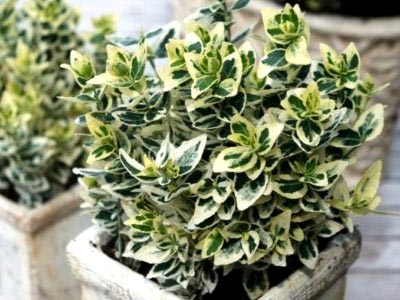

Features of the care of the Euonymus at home
Euonymus is a relatively unpretentious plant that does not require complex care.
Watering and spraying
Aloe tree - what is it, description of the plant
Watering is moderate, as the soil dries out completely.
The moisture level does not really matter for the plant. It is necessary to spray the bush only if it is a houseplant. The procedure is performed during a period of intense summer heat. Helps additional hydration of the leaves to prevent plant diseases.
Attention! Water is used only boiled or filtered, otherwise plaque will remain on the leaves. In the summer, a potted bush can be watered from a shower with warm water, but then the ground must be covered with polyethylene.
Priming
Euonymus likes soil with neutral or weak acidity. If the soil is acidic, add lime. The soil should be loose and light to provide aeration to the roots.
The recommended soil composition for a home bush in a pot is garden soil, peat compost, sand and lime or ash, with the addition of a small amount of complex fertilizers.
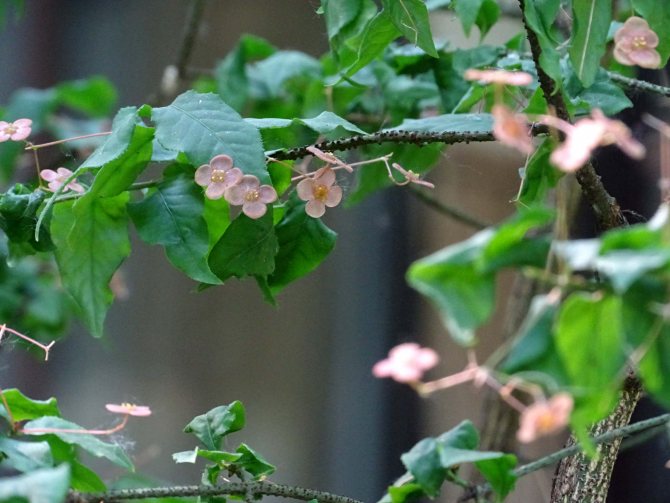

The flowers of the euonymus are small, inconspicuous
Top dressing
Top dressing is done 2 times a year. Complex inorganic fertilizers are used.
Euonymus in winter
The euonymus is perfectly adapted to low temperatures. The winter hardiness zone of different species varies from 6 to 4. That is, the plants are able to withstand from -20 to -35 degrees of frost.
Despite the hardiness, young shrubs should always be covered for the winter. To do this, use pine spruce branches and dry foliage. Adult shrubs that have reached the age of three do not need shelter.
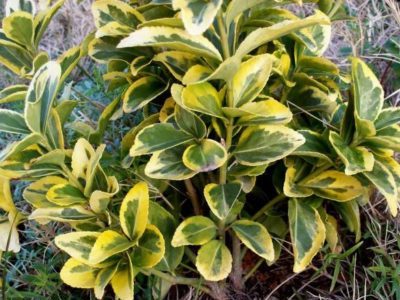

Signs and superstitions
The people believe that the euonymus growing near the house protects the owners from troubles and misfortunes, and it is recommended to keep its fruits as a strong talisman.
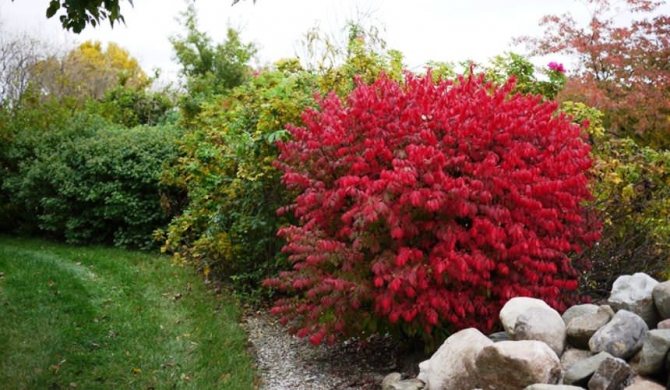

Euonymus - protective talisman
The warty euonymus, despite its not very pleasant aroma, to which all the flies in the area flock, is a pleasant-looking plant, a rich bush with a lush crown. It will decorate a garden or a summer cottage, becoming a bright accent in landscape design.
Propagation of euonymus by cuttings in water
Cutting is the easiest and fastest way to propagate euonymus, which should be carried out in June. To do this, cut off the cuttings seven centimeters long from the bush. A good cutting should be young and strong with two knots of foliage. Place the cuttings in a jar of water until the roots appear.
When roots have formed, transplant the cuttings into fertile pots. The plants will take root in a month. Keep them out of direct sunlight. Monitor the soil moisture and ensure the room temperature is + 20 ° C.
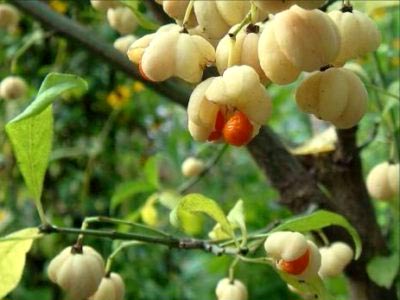

How the warty euonymus reproduces
Many novice gardeners are interested in euonymus: how to propagate it to get many new bushes. The most common ways how euonymus reproduces are by seeds, cuttings, air layering and division.
Germinating seeds
Barberry Thunberg - description of plant varieties
It is very difficult to propagate by seeds, and therefore this method is rarely used. The seeds are buried in the nutrient soil, covered with earth, and watered. Above the box with planting material is closed with polyethylene or glass. Placed in a warm place. The film is removed daily for 20-30 minutes to ventilate the soil. The first shoots may appear in 1.5 - 2 months.
Attention! Due to the fact that the seeds are surrounded by too dense skin, it is difficult for them to germinate. From the many seeds planted, only a small fraction of them can grow.
Rooting cuttings
Propagation by cuttings of euonymus is the preferred method, which always gives the desired result. It will be described in detail below.
Air layering
The young shoot is pressed to the ground, fixed with staples, and sprinkled on top with a thin layer of nutritious soil. The next year, the earth is dug up - if the root system is formed at the shoot, it can be separated from the mother bush.
Other options
Thanks to its superficial roots, the bush can be propagated by dividing. The survival rate of this technique is good, the main thing is to act carefully when dividing the roots so as not to damage them.
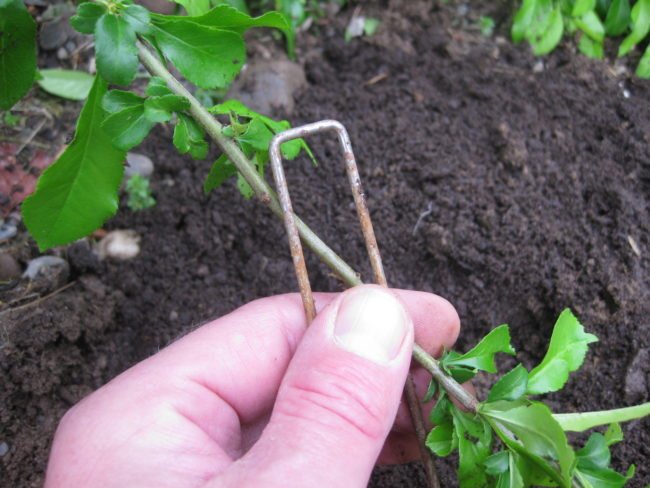

Euonymus can be planted with air layers
Growing euonymus from seeds
Seeds - euonymus is difficult to propagate with seeds. In order to successfully plant the seeds, you need to prepare them using the stratification method.
To do this, mix them with calcined sand or semi-decomposed peat in a 1: 2 ratio.
Stratification
Keep the seeds at + 10 ° C for three or four months. Under such conditions, the seed coat should burst.
After the destruction of the shell, reduce the temperature, which should be from 0 to +3 ° C. Store the seeds under these conditions for another four months.
Sowing seeds
After eight months of preparation, you can start sowing. To do this, pour a ready-made substrate containing leafy earth, humus, sand in a 4: 2: 1 ratio into a plastic container.
Plant the seeds in the soil two centimeters deep. The first shoots will appear in two weeks. It is recommended to mulch seedlings with peat chips in a layer of up to three centimeters in spring and autumn.
Water and feed the seedlings with mullein in the summer. In winter, cover with pine twigs and dry foliage. When three years have passed, the mature euonymus bushes can be transplanted into a pot or open ground.
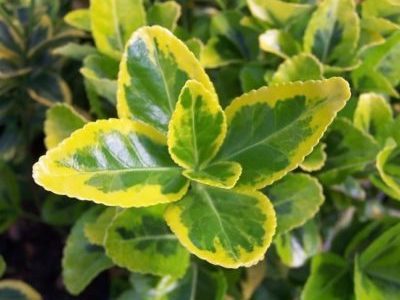

Diseases of euonymus
The bark of the branches has changed color - the cause is various fungal pathogens. To heal the plant, cut off the affected branches. Treat the sections with oil paint based on natural drying oil. Spray the rest of the branches with a burgundy mixture or Abiga-Peak fungicide.
Leaves dry and fall off - caused by direct sunlight and high indoor temperatures. Move the shrub to a shaded area with moderate temperatures.
Stopped growth - there are several reasons for the slowdown in growth: waterlogging of the soil - stop watering for a while; old soil - change the substrate to a new one with fertilizers; infested with pests - rinse branches and leaves with rubbing alcohol.
Does not bloom - is not a disease. The main reason is that euonymus very rarely produces flowers at home.
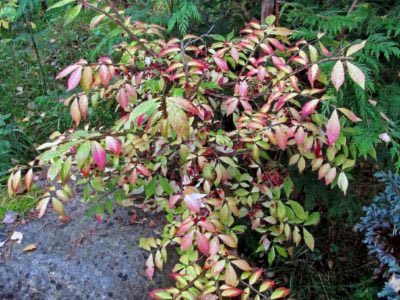

How grafting works
Important factors that guarantee high-quality reproduction of euonymus by cuttings are good condition of the stems, timely protection from sunlight, provision of moisture, oxygen and heat. It is worth noting that too early contact with the sun can result in the death of the shoots. Dry soil will also adversely affect their condition.
Propagation of euonymus by cuttings is as follows:
- It is necessary to cut the required number of cut tops of the shoots with internodes. It is advisable to cut cuttings from a plant that is five or more years old.
- Carefully process each cut with a root root, which will contribute to the active formation of the root system.
- Plant the prepared cuttings in sand and peat soil. It is advisable to do this in a greenhouse, where it is quite warm and it is possible to maintain optimally suitable conditions for rapid growth.
- The grafting procedure is usually done in the summer (June-July), and already in the fall, good roots appear, which indicates that the euonymus is ready for planting in a permanent place of growth.
By cuttings, euonymus of such varieties as Winged, Maaka, Big-winged, Sacred are propagated. But for varieties Broadleaf, Cork, this breeding method is not suitable.
Spindle tree pests
Spider mite - a white cobweb appeared on the shoots, and black dots on the leaves. To get rid of the pest, treat the leaves and stems with a soap and alcohol solution.
Aphid - shoots and leaves are covered with small green or brown insects. Aphids cause many beige spots. A soap solution or tincture of pine needles will help to overcome the pest.
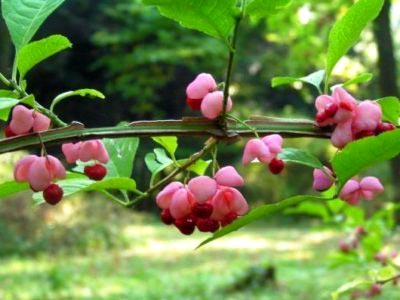

Possible growing problems
Despite the unpretentiousness of the plant, when growing euonymus, you can encounter a number of problems, the main one being pest control.
Diseases
Common plant diseases:
- The mosaic is viral - yellow spots appear on the leaves.
- Powdery mildew - white bloom on the branches.
- Necrosis - the bark changes color, cracks, its detachment and death occurs.
It is impossible to cope with viral diseases, because the bush will have to be destroyed. Fungicides are used to treat fungal diseases. With a protracted course of the disease or if the case has been started, the treatment is carried out 3 times, every 2 weeks.
The cause of disease is mainly due to improper watering. Fungal diseases and root decay are the result of excessive overflow of the plant.
Attention! To make the euonymus feel comfortable, it must be planted in partial shade. Abundant sun and direct rays negatively affect the growth of the bush, the condition of its leaves and flowering.
Pests
Euonymus is called a purifier. It attracts various insects, thereby saving other plantations on the site from them. Of the pests, bushes are often attacked - tick, mealybug, apple moth, aphid. Pest control is carried out by treating the plant with insecticides.
Euonymus medicinal properties
Euonymus has long been used for medical purposes. This plant helps to cope with many diseases. The bark, branches, seeds and leaves have healing properties. They contain many useful substances: carbohydrates, vitamin C, sucrose, higher fatty acids, alkaloids, tannins.
Various decoctions and tinctures help to normalize blood pressure, normalize the work of the heart muscle, and cure diseases of the stomach and intestines. Euonymus is also used to treat nervous disorders and headaches.
Tincture and decoction recipes
Migraine decoction: take a few twigs, fill them with two glasses of water and boil for five minutes, let the broth cool. Consume two tablespoons three times a day for a week, then take a monthly break.
Tincture for hypertension: Mix the bark and alcohol in a 1:10 ratio. For example, ten grams of bark and one hundred grams of alcohol. Let the medicine sit for two weeks. Consume seven drops three times a day for two weeks, then take a month off.
What does the warty euonymus look like, which family does it belong to?
The plant belongs to the genus Euonymus, the family Euonymus. Description:
- deciduous bush, height up to 4 m;
- young shoots are green, in an adult plant, the branches are brown, the bark is rough, with growths of gray-brown color;
- in summer, the leaves are light green, elliptical, up to 8 cm long;
- starting in September, the leaves take on a different shade - from yellow to deep purple;
- inflorescences are small, inconspicuous, no more than 0.8 cm in diameter, the color is brown with purple impurities;
- aroma - unpleasant, viscous nectar, attracts only flies.
Additional Information! The rough growths of bark on the branches, which look like numerous warts, are necessary for the plant to breathe.
Healing properties
There is a well-known warty euonymus, the description of which reveals a picture of a sprawling, beautiful bush, with its therapeutic effect on the human body.
Leaves and fruits are used in folk medicine for the preparation of decoctions, tinctures and lotions for the treatment of the following conditions:
- prolonged headaches;
- hypertension;
- liver disease;
- impotence;
- intestinal disorders;
- heart rhythm failure;
- disorders of the central nervous system;
- swelling.
Attention! Euonymus is a poisonous plant, therefore it is strictly forbidden to use it for the preparation of medicinal products on your own. For treatment, minimum dosages of drugs are used, which are determined only by a doctor.
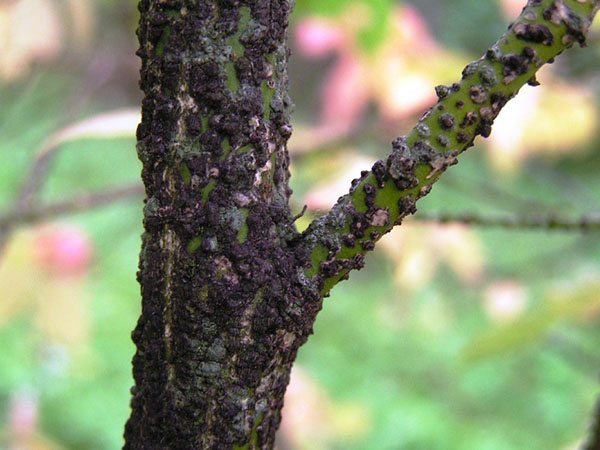

"Warts" on the trunk - the respiratory organs of the bush
Briefly about the history of appearance
There are many legends about the appearance of the bush. One of them says that the euonymus was invented by a witch, offended by people, and she endowed it with a potent poison, while making it very attractive.But seeing human suffering, the witch changed her anger to mercy, and made the fruits of the euonymus healing.

